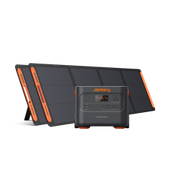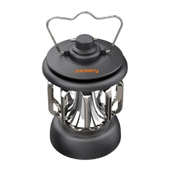How To Use A Generator
You don't know when you might face a power outage that can last a few hours or days. No matter what causes the power outage, it only results in you having no power to run your house's electronic and electrical devices.
You can use a generator as a backup energy supplier during a power outage. This article guides how to use a generator during a power outage. It covers the details of using a gasoline or solar generator to supply electricity to your house when the power is down.
Estimate Your House’s Power Needs
Before you use a portable generator to power your house, you have to make a list of each item you want to power to estimate the power needs. You need running during a power outage including refrigerators, lights, fans, chargers, and media devices. Most of these devices come with a data plate or an owner's manual that tells you the wattages required to run them. Large electric appliances need more wattage when starting, so make sure you check that as well.
After you determine the running watts of all the appliances you want power, add them to find out the total wattage you need from the generator. Check it with your portable generator's starting and running wattage, and you are good to go. Before you learn how to use a generator during a power outage, remember that overloading a generator can cause damage to the connected appliances. It can be permanent or costly to fix.

Image Source: stvdomrep.wordpress.com/energy-demand-estimation-and-calculation
How to Use a Generator at Home
STEP 1: Place the Generator
- Don't place the generator inside your house. If you have a gasoline-powered generator, make sure to position it at least twenty feet away from your and your neighbor's house. Also, place its exhaust away from windows and doors.
- Never place your portable generator in an enclosed space like your basement or garage. Make sure it is not closer than 5 feet to any walls or roof. Also, keep it in a dry area and away from high temperatures.
STEP 2: Plug in and Start
- Always use a heavy-duty exterior cord for more safety when you plug in your portable generator. You must lay out the line before you start the generator.
- Make sure that no cord is plugged-in when you start the unit.For a gasoline generator, you have to pull the choke handle and then hold the start key or button to start it. For solar generators, you only need to flip one switch to start the unit.
STEP 3: Plug-in Appliances
- After you let your generator run for a few minutes to warm up, you can start connecting appliances. Make sure to connect one device at a time to avoid overloading and plug in the item that needs the most power first and follow that order for other items.
- You will need an extension to plug in multiple appliances with a gasoline generator. Most solar generators can directly connect multiple items without an extension.
STEP 4: Refuel the Generator
- When it's time to refuel the generator, plug out all the appliances and run the generator for a few moments. Then, power it off and also turn the fuel switch. Wait for the unit to cool down and then refuel.
- For solar generators, all you have to do is connect solar panels and place them outside to receive sunlight for a few hours. If you are using a good-quality solar generator, you will be able to recharge it while using it.

Pros of a Generator
- 1. Automatic distribution of power.
- 2. Ease of mind during storms and blackouts.
- 3. Runs the heating and cooling systems of your house.
Cons of a Generator
- 1. Generators are noisy
- 2. If not used properly, then it may be dangerous for your appliances.
- 3. Environmental pollution
How to Use a Portable Generator?
Jackery solar generators are a combination of solar panels and portable power stations that convert sun energy into electricity and store it for later use. It is a renewable, clean power source with zero fuel cost. If you want to know how to use a solar generator during a power outage, it is better to discuss how much energy you can get from a solar generator and what appliances can easily run on it. Let's take the Jackery Solar Generator 2000 v2 as an example, as it is one of the best units for normal usage. You can run 85% of appliances in your house with it, including your refrigerator and microwave oven. You can easily recharge it up to 80% within four hours with solar energy.

How to Use a Solar Generator During a Power Outage?
Follow this guide if you want to know how to use a solar generator during a power outage.
STEP 1: You have to start by checking the electricity capacity left in your solar generator. You can easily check it by pressing the display button to turn on the LCD screen. To ensure that you are prepared for a power outage all the time, check the electricity capacity every three months.
STEP 2: Plug in the appliances you want to power after you estimate the running wattage of each appliance. The Jackery Solar Generator 1500 provides you with 1800 wattage of AC output, 110 ACV, with a peak of 3600 wattages.
STEP 3: To recharge your solar generator, all you need to do is place the solar panels in sunlight and let them do a solar recharge for four hours to recharge up to 80%.

Pros of Solar Generator
- 1. It is safe and easy to use.
- 2. Rechargeable with no maintenance cost.
- 3. No pollution and zero emissions.
- 4. Quiet
Cons of Solar Generator
- 1. Limited power output for commercial use
FAQ
1: How to Use a Solar Generator for a Fridge During a Power Outage?
First, you have to check the running and start wattage of your fridge from the owner's menu or data plate. Most refrigerators require 350W energy to run, so let's take that as your reference. With the Jackery Solar Generator 1500, all you need to do is plug in the fridge directly and run it until the power lasts. If you don't connect other appliances to the Jackery Solar Generator 1500, it can run your fridge for up to 4 hours if it is fully charged.
2: How to Use a Generator at Home?
Before discussing how to use a generator at home, let's get one thing straight. If you have a gasoline generator, you can't use it inside your house due to CO emissions. You have to place it outside and away from your windows or doors by at least 20 feet. If you don't want this extra trouble, use a Jackery Solar Generator that runs with zero emissions and is entirely safe for in-house usage. Just recharge the unit using solar panels and plug in the appliance you want to run. Before you connect the appliances, make sure to estimate the required wattage to avoid overloading the generator.
Conclusion
Let’s conclude our guide on how to use a generator during a power outage here. With different types of portable backup generators in the market, it is not simple to decide which one to use. Suppose you are looking for an easy-to-use, safe, and environment-friendly generator with zero fuel cost. In that case, getting a Jackery Solar Generator is your best pick. They make zero sound and charge quickly within 1.8 hours (Jackery Solar Generator 1000Pro) in sunlight. To use a solar generator, first, you must count the wattage you need to run the appliance in your house. After making a list, you have to check the electricity capacity on the unit and start plugging in the appliance directly. Don't miss subscribing to our newsletter for product news and exclusive promotion.
Disclaimer:
The runtime mentioned for appliances powered by Jackery is for reference only. Actual runtime may vary under different conditions. Please refer to real-world performance for accurate results.












































































































Leave a comment